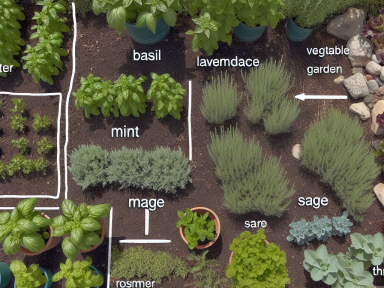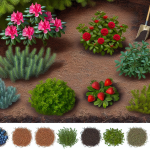Introduction to Herbal Borders for Natural Pest Control
Creating herbal borders in your garden is not only an aesthetically pleasing way to separate different sections of your garden, but it’s also a highly effective method of natural pest control. By strategically planting certain herbs, you can protect your garden from unwanted pests without the need for harmful chemicals. Below, I will reveal the specifics of how to create these herbal borders and which herbs to use for the best results.
Key Herbs for Herbal Borders
1. **Basil** (*Ocimum basilicum*)
– **Repels:** Aphids, mosquitoes, and whiteflies.
– **Planting Tips:** Grow basil in full sun with well-drained soil. It thrives best when watered regularly but does not like soggy roots. Place it around tomatoes to repel tomato hornworm.
2. **Lavender** (*Lavandula*)
– **Repels:** Fleas, moths, and mosquitoes.
– **Planting Tips:** Lavender prefers full sun and well-drained soil. It is drought-tolerant once established. Ideal for planting along the edges of your garden or as a border around seating areas.
3. **Mint** (*Mentha*)
– **Repels:** Ants, mosquitoes, and fleas.
– **Planting Tips:** Mint can be invasive, so it is best grown in containers or with root barriers in place. It thrives in partial shade to full sun and moist soil. Place containers of mint near doorways and windows to prevent pests from entering your home.
4. **Rosemary** (*Rosmarinus officinalis*)
– **Repels:** Cabbage moths, bean beetles, and carrot flies.
– **Planting Tips:** Rosemary requires full sun and well-drained soil. Plant it around the edges of vegetable gardens to protect crops from pests. It also makes an excellent hedge.
5. **Sage** (*Salvia officinalis*)
– **Repels:** Carrot flies and cabbage moths.
– **Planting Tips:** Sage enjoys full sun and well-drained soil. It pairs well with cabbage and carrots, protecting them from pest invasions.
6. **Thyme** (*Thymus vulgaris*)
– **Repels:** Cabbage worms and whiteflies.
– **Planting Tips:** Thyme prefers full sun and well-drained soil. Plant it in rock gardens, along pathways, or as a border for your vegetable garden.
Planting Your Herbal Borders
1. **Choose the Location:** Determine where you most need pest control. Common areas include the perimeter of vegetable gardens, near entryways to your home, or around outdoor seating areas.
2. **Prepare the Soil:** Ensure the soil is well-drained and fertile. Amend with compost if necessary.
3. **Space Strategically:** Plant herbs according to their individual spacing requirements. For example, lavender and rosemary need more room to spread compared to thyme or basil.
4. **Companion Planting:** Consider companion planting techniques to enhance the effectiveness of your herbal borders. Group herbs with compatible vegetables and flowers.
Maintenance Tips
– **Regular Watering:** Keep the soil consistently moist, but avoid waterlogging. Each herb has different watering needs, so be mindful of the specific requirements of each plant.
– **Pruning:** Regularly prune your herbs to encourage bushier growth and prevent any one herb from becoming too dominant.
– **Pest Monitoring:** Though these plants repel many pests, keep an eye out for any signs of infestations, and take early action if needed.
Conclusion
Herbal borders not only enhance the beauty of your garden but also serve as a natural deterrent to pests. By carefully selecting and planting these herbs, you will create a healthy, harmonious garden ecosystem. Remember, the key lies in understanding each herb’s specific needs and the pests they repel, ensuring you get the maximum benefit from your herbal borders. Happy gardening!



GIPHY App Key not set. Please check settings